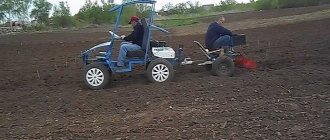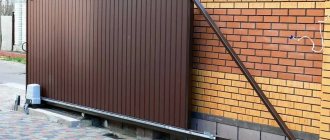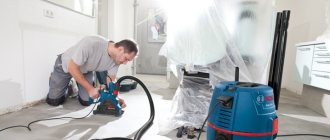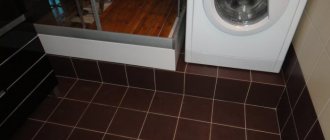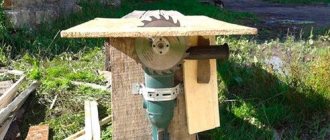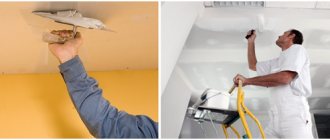What can tripods and rods be made from?
There are several options for making the tool: from a telescopic, polypropylene, aluminum tube, or from a metal profile.
Available materials are used as a basis; some parts (for example, the head) can be purchased separately. In any case, making the design yourself will be cheaper than buying it in a store.
What tools and materials will be needed
To manufacture the device you will need the following tools and materials:
- pipe with the following parameters: cross-sectional diameter 27 mm, wall thickness 1 mm;
- handle for telescopic roller;
- glue “Moment” (you can also use a glue gun);
- part of the rug;
- Screwdriver Set;
- self-tapping screws;
- stationery knife;
- head from an inexpensive tripod;
- metal corner 40*100 mm;
- plastic clips for Ø 25 and 20 mm – 2 pieces each;
- drill;
- sealant gun (can be old);
- coupling (needed for support from below);
- polypropylene tee (32 mm);
- screw 4-6 mm, wing;
- plastic screws (5/8 thread).
Method No. 3
For another option for making a laser level, you will need a basin of water. The fact is that the horizontal water plane can serve as a basis for tuning the laser beam.
They act this way:
- Pour water into a basin or wide bucket under the rim.
- Take a piece of foam plastic and fix the laser pointer strictly in the middle.
- The foam is placed on the water and the pointer is turned on.
- The container is placed at the level of the future line on the wall that needs to be marked.
- Turn the laser in the desired direction and mark points on the wall with a pencil.
Important! If this method is chosen to create a laser level, you need to take into account that if the pointer is not centered correctly and there is a skew to one side, the horizontality of the beam will be disrupted. The marks will be set incorrectly.
How to make a telescopic rod for a laser level with your own hands
The telescopic design rises to any height, making it convenient to work in different rooms. To make it yourself, proceed as follows:
- Glue the threaded sleeve with two-component glue.
- Raise the instrument as high as possible, resting it on the ceiling.
- Tighten the nut from below to select the optimal height.
- Markings are applied on a small piece of plywood.
- Cut out the part (bracket) according to the marks with your own hands.
- Using a metal clamp, it is necessary to fix the wooden bracket at the required height.
- Adjust by turning in the desired direction.
Move a mark
Let's figure out how to move the elevation mark using a level. For example, we need to make a benchmark, based on which the excavator operator will dig a pit, two meters deep below the floor level of the building. The value of the floor height is what we need to indicate to the excavator operator.
We install the rail at the reference design point, the height of which corresponds to the design height of the building’s floor, that is, zero, and take a reference. When independently developing a project or when → linking an existing project to the area, the height of this point is set using a peg or a mark is set on some fixed surface (brick fence, tree, pole, etc.). Or such benchmarks (marks) are set by a surveyor accompanying the construction site. Let, for example, it turn out to be 162.
Directly at the site of the future pit, we drive in a peg and, placing the rail close to it, again take the value, let it be equal to 179. The difference will be 17 centimeters. We set aside 17 cm from the bottom of the batten up the peg, mark the value with a marker or pencil. By driving another peg nearby so that its top coincides with the notch, we get a clearly visible landmark, after which the peg with the notch can be removed.
How to make a tall tripod for a laser level from propylene pipes with your own hands
From leftover polypropylene pipes you can make a microlift for a laser level with your own hands. The step-by-step instructions are as follows:
- First, blanks are made from nine scraps of polypropylene pipes. This quantity is enough to construct three legs. If the length of each fragment is 60 cm, you can use them to make a spacer stand for a laser level with a height of 50-100 cm with your own hands.
- Take six pieces out of nine and place them on one part of the coupling. You need to work using a welding iron. After this, 3 trims are laid in one row (in the center there is a regular polypropylene pipe without a coupling).
- The next stage of making a stand for a laser level with your own hands is to place a piece of plywood or MDF panel on top and secure it with clamps. Next you need to drill holes and make threads. Screw the workpiece using screws. Assemble the remaining two legs with your own hands in the same way.
- A long self-tapping screw must be inserted into the middle polypropylene pipe of each leg. You can use it to install a homemade tripod if the surface is uneven. Then you need to fix the legs together using three corners.
Important! Using the technology described, you can make a tripod for a laser level with your own hands. This is a convenient device that does not take up much space. It can be used as a tripod not only for a level, but also for a camera, level and other tools.
Selecting components
Now let’s finally decide which parts of the level’s design you should pay special attention to:
- The rotation unit is integral with the base of the emitting head.
- Support with independent vertical installation.
- The emitting head is a laser pointer.
- 2-axis level for precise installation of the leveling unit.
Rotation unit
This leveling module is easiest to make using sliding friction from slab materials manufactured with a surface evenness of at least 0.5 mm/m. An additional condition is that the material, without losing its properties, must be amenable to processing with hand tools and subsequently withstand operating conditions. Based on the results of the selection (there is no room to dwell on the details here), the following are suitable, in descending order of degree of suitability:
- Postforming is a thick, high-density fiberboard used to make countertops for kitchen sinks and the like. The evenness of the surface of postforming slabs of 0.25 mm/m is not uncommon. Postforming is wear-resistant, does not warp from splashes and dust; In order for it to swell, it must be soaked thoroughly and not allowed to dry for a long time.
- Furniture laminated chipboard with a thickness of 16-24 mm. Forming accuracy is no worse than 0.5 mm/m. Evenness is not lost from splashes and dust, but in terms of wear resistance, the material in the level will last 3-5 seasons. Excessive moisture without immediate wiping and drying causes irreversible warping. Blanks for the device parts (see below) must be cut with an indentation of at least 5 cm from the edge of the board, because slabs of edged furniture laminated chipboard have a sheer edge across the layers of up to 1 mm.
- Laminated MDF with a thickness of 12 mm. Surface evenness approx. 0.5 mm/m. In terms of wear resistance, MDF of at least class 33 is suitable for a level (the first number in the designation characterizes mechanical strength; the second – wear resistance). With slight moisture it swells irreversibly.
Note: other fibrous and layered materials (plywood, including birch plywood, OSB, laminated plastics, e.g. textolite) are not suitable for evenness and/or operational durability.
L, M and H
Pressed wood fiber boards (fiberboards) are available in 3 types. Their basis is fibrous lignin isolated from ground wood pulp; as a rule, from wood processing waste. The properties and cost of the material are determined by the quality of the raw material (degree of lignin purification), temperature and pressure during its pressing.
Low Density Fiberboard (LDF) is a well-known fiberboard used to make backings for cabinet furniture, etc. Medium Density Fiberboard (MDF) is also a well-known substitute for MDF commercial wood. But High Density Fiberboard (HDF) is postforming. This material is called so because it is supplied to product manufacturers not as finished slabs, but in the form of a loose mass, which is pressed into tabletops, etc. The reason is that lignin is of high purity, every crumb is protected, and it was better to waste some of the material when cutting slabs would be unprofitable.
Support
Photo/video tripod, suitable for use as a support for a homemade level
The best option for an independently adjustable level support is a tripod for photo and video cameras. It can also be useful in many other cases, even if you never shoot anything on camera.
Don’t look for an old Soviet tripod on the cheap - the ones that went on sale are outright rubbish. But a modern photo-video tripod device is not that expensive and the price fits into the conditions specified at the beginning.
Any modern photo and video tripod is stable enough to withstand construction site conditions. When choosing, pay attention that (see figure on the right), firstly, the tripod is equipped with its own 2-coordinate level - it is on this level that the support is installed vertically on an unprepared surface. Secondly, adjustment and use of the level will be greatly facilitated by at least a rough degree scale; both are shown by arrows in Fig. And then look at the price, which one suits you.
Leveling pan?
In RuNet you can find instructions: they say, fill a saucepan or basin with water to the top, let a piece of foam float there, put a laser on it - and level it out for your health. Sorry, this is an absurd invention.
Firstly, the entire floating craft will float on the water without heeling only if the projections of the center of buoyancy of the float (CB) and the general center of gravity of the device (CG) coincide. This is theoretically possible; practically impossible. Can you imagine a ship with empty holds and cargo piled high on the deck? Container ships take cargo on deck only when the hold is full, and even then they are the most dangerous of ships.
Secondly, the container with water is not the sea or even a pond or puddle after rain. The float with the laser is already tilted by the forces of surface tension of the water in the vessel. The tilt of a float with a diameter of 10 cm of 0.5 mm is invisible to the eye, but the marking error will be more than 5 mm/mm. What kind of leveling is there...
Pointer
Have you ever had to disassemble the laser head of a level? If so, think about what it is most similar to structurally. More precisely, which of the laser pointers.
For the cheapest one without any optical effects, see Fig. It is precisely these keychain pointers that, as a rule, do not require additional adjustment of the emitter when setting up the level. If this is required, it is carried out simply, quickly and reliably.
Laser pointer-keychain, suitable for use in a homemade level
You need to choose a keychain pointer for a homemade laser level that does not have annular protrusions on the body; it should be a simple cylinder; this will make it easier to adjust the device. The only drawback of a cheap keychain laser pointer is its rather large light spot. But determining its center by eye and putting a mark there is a child’s task.
Level
For a 2-coordinate level for a homemade level, it is best to take a round bubble one, but a T-shaped one will also work, see figure. There are a sea of round bubble levels on sale, in sizes ranging from a button to a plate. For a level you need a level with a caliber of 20-25 mm and a thickness of up to 15 mm. Better is a precision one, with cross marks and degree inclination marks, but a simple one, as in the figure, is generally no worse.
Bubble two-coordinate levels round and T-shaped
Note: If you search for additional information on this topic on Google, do not type “2-axis bubble level.” The popular search engine does not understand what it is and produces a few results that are actually irrelevant to the matter. Type "round bubble level".
How to make a bracket for a laser level with your own hands
The bracket is a holder with which the tool is attached directly to the support (tripod). You can also make it yourself using these instructions:
- Prepare the aluminum and telescopic pipe.
- Insert the second part into the main cut and secure with a clamp.
- Secure the metal corner to the clamps.
- Tighten with nuts.
- Place it against the ceiling and secure it.
- Place the device on a tripod and get to work.
Level device
Let's look at what a regular optical level consists of and how it works. The main part of the device is an optical tube with a lens system capable of zooming in on observed objects with a magnification of twenty times or more.
The pipe is mounted on a special rotating frame, necessary for the following functions:
- tripod mounts;
- setting the optical axis of the level to a strictly horizontal position, for which the frame has three height-adjustable “legs” and one or two (in models without automatic adjustment) bubble levels;
- precise horizontal aiming, which is carried out with paired or single handwheels.
In some models, the bed has a special dial, a scale that allows you to measure or construct horizontal angles.
On the right side of the pipe there is a handwheel designed to adjust image sharpness.
Adjustment to the operator's vision is made by rotating the adjustment ring on the eyepiece.
When looking through the eyepiece of a level telescope, we will see that in addition to bringing the object observed through the device closer, the level superimposes a system of thin lines on its image, called a reticle or reticle. It forms a cross-shaped pattern of vertical and horizontal lines (see Figure 1).
How to make a magnetic holder for a laser level with your own hands
The magnetic tripod is made of a metal profile. The sequence of actions is as follows:
- Draw up a drawing and apply markings.
- Saw off part of the workpiece.
- Get a strip from a metal plate.
- Sand it down.
- Bend at a right angle.
- Drill three holes in the workpiece.
- Screw a bolt into each of them.
- Place the ends and nail them with a hammer.
- Screw the corner to the main part.
- Attach the bracket to the tripod and place the instrument.
Principle of operation
The basic element of any device whose name includes the word “laser” is an emitter of highly targeted monochromatic (one-color) radiation. The phenomenon is based on forced radiation, which, depending on the power, is perceived differently. Low-power laser emitters based on red, red-orange, yellow-orange and green diodes make it possible to produce a point or beam of light. At a high level of pumped energy, a laser beam can turn into a weapon - it can set fire to materials that absorb radiation well.
Devices used in everyday life and construction and repair work operate on laser diodes of the red, yellow-orange and green spectrum; blue and violet ones are much less common (such models are much more expensive). To concentrate light radiation, biconvex lenses are used, as well as other optical devices that allow the beam to be converted into a plane.
Household appliances have a standard circuit shown in the illustration. Design variations are related to the power of the emitter and additional accessories.
Checking the device for correct installation
Much depends on the accuracy of the measurement results carried out by the device. If the plane for laying tiles is knocked off, then the evenness of the installation of the tool will affect the interior design. If the plane is checked during the construction of a house, then the installation of the level will affect the quality of construction and the reliability of this structure.
Each device (depending on the model and its cost) has corresponding error indicators
The permissible error values are indicated directly in the instructions for the equipment, which should be taken into account when purchasing a tool. Acceptable error values are indicated in the appropriate units of measurement, which are mm/m
Errors are not so important when using the device indoors, but they are extremely necessary when carrying out external work on beating a plane and leveling walls.
The error is one of the main technical parameters of the instrument, and some manufacturers indicate the magnitude of deviations not only in the technical documentation, but also on the body of the device. If the magnitude of the error is known, then the permissible deviation from the norm can be calculated. If the deviation value is higher than permissible, it is recommended to use a level with a smaller error value.
It doesn't matter if the laser level is being used to level a floor, wall or ceiling, but before taking the corresponding measurements, you will need to check the accuracy. The check is quite simple, for which the following steps are performed:
- First you need to put marks on two parallel walls in the room, according to which the check will be carried out
- One mark is placed on the wall that is closer to the device (at a distance of up to 1 meter)
- The second mark is placed on the opposite wall, located at a distance of more than 2 meters. The further the distance between the walls, the more accurately device deviations can be identified
- After marking with a marker or pencil on the wall, you need to move the level directly to the wall, which was further from the level
- Align the directional laser beam with the point that was marked. Then project the beam onto the opposite side and see if it matches the mark
- If it matches, then the instrument has an insignificant error (note that the greater the distance between the walls, the higher the error, and the smaller the gap between them, the correspondingly lower the error)
- If the laser beam does not coincide with the mark, then there is an error, and its magnitude is quite high. There are special adjustment screws in the device body, which also allow you to adjust the level, reducing deviations from the norm
Before using a laser level to level walls, you need to make sure that there are no large deviations, otherwise the indicators will not correspond to reality. Below is a video instruction and training on how to properly check the level for measurement accuracy.
https://youtube.com/watch?v=ffrWqniqrfs%3F
Design features
The construction bubble level belongs to the category of simple, but most popular devices for repairs. Ampules with air pumped inside are installed on the bar protruding as a solid base. The ampoules have marks for measuring and determining the position of the air. When the bubble is placed in the middle, the surface is considered flat. If it moves away from the central part of the ampoule, then there is a tilt, the magnitude of which is estimated by the nature of the deflection of the air relative to the center.
The ampoule containing the air bubble contains liquid, usually industrial alcohol. The integrity of the ampoule must not be compromised.
Instruments vary in length - from several tens of centimeters to 2-3 meters or more. When working on limited surfaces, short structures are used, and in plastering work, longer ones are used. For example, for laying tiles, choose a level length of 400-1000 mm.
Long structures are susceptible to damage during transportation and operation. Therefore, shockproof structures are in demand.
Various materials are used to make the base. In the photo of the bubble level you can see products with a solid wooden or hollow aluminum and plastic base.
For metal, devices with built-in magnets are more suitable, and the presence of a ruler on one side of the bar makes marking work easier.
The accuracy of the work is ensured by several ampoules included in the design:
- the first is located on the surface of the wide part of the level and is used for horizontal alignment;
- the second is placed on a narrow and short surface for operations with a vertical orientation;
- the third is not available in all models, but its presence on the back side of a narrow plane at an angle of 45 degrees is useful for monitoring the correct operation.
The level should be applied to the wall, first leaning it against the nail. It is necessary to level the position so that the bubble shows alignment. A line is drawn on the plane of the wall. The device is turned over and the line is drawn again.
If the lines match, then you can be sure that everything is configured correctly. Otherwise, you need to make corrections:
- on the right, where the marks diverge, a mark is placed in the center between the lines;
- a level is applied to the screw, but this is done so that the other end coincides with the marking point;
- the position is fixed;
- The ampoule must be adjusted to the required position.
